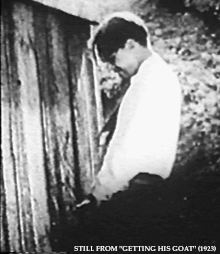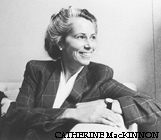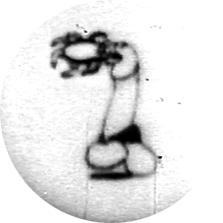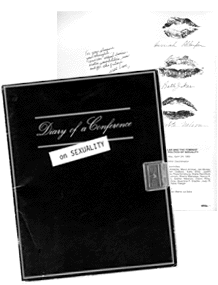
LEARNED TO LOVE DIRTY PICTURES
BY M.G. LORD
IT WAS A SUNNY OCTOBER AFTERNOON AT UC-SANTA BARBARA, AN AGGRESSIVELY verdant campus with signs explaining, in both English and Spanish, that its lawns had achieved their lushness through "reclaimed" water. Inside Buchanan Hall, however, the lights were dim, and the atmosphere less Arcadian. Twenty-five or so undergraduates slouched in their seats, staring at a movie screen. Around three o'clock, film studies professor Constance Penley entered in an elegant silk trouser suit and small hair, which seemed to belie the "Florida cracker childhood" she had laid claim to in her 1996 essay "Crackers and Whackers: The White Trashing of Porn"--that week's reading assignment. "Are you ready," she asked the class, "for porn marathon day?"
Evidently, the students were. With a startling absence of nervous titters, they sat through John Wayne Bobbitt: Uncut, a sexually explicit reenactment of the infamous amputation; Getting His Goat, a sepia-toned stag film from 1923 in which a man, duped into believing he is having sex with a woman through a hole in a fence, engages in intercourse with a goat; and, finally, Buried Treasure, a cartoon, circa 1930, from a major animation studio depicting the antics of a hapless man and his immense, dancing anthropomorphic penis.

Afterward, Penley stood up and made brief remarks. The films, she said, "should be of great interest to feminists, insofar as they parody male vainglory, narcissism, and sexual and social ignorance." But there was no time to challenge her provocative conclusions: Northwestern University film studies professor Laura Kipnis was slotted to speak at four. Kipnis is best known for her 1992 essay "(Male) Desire and (Female) Disgust: Reading Hustler," a groundbreaking class-based analysis of the lowbrow porn magazine. Long before Milos Forman and Oliver Stone transformed Hustler's paraplegic publisher into a First Amendment martyr in The People vs. Larry Flynt, Kipnis had hailed him as "a one-man bug up the nation's ass" for having embraced and promoted "those narratives exiled from sanctioned speech and mainstream political discourse."

Addressing a few dozen earnest undergraduates on the Santa Barbara campus, Kipnis riffed on her new interests: presidential adultery and "the problem of Bill Clinton's thighs." After Kipnis finished speaking, an admiring female student presented her with an inscribed copy of a paper the young woman had published in UCSB's undergraduate film journal. Titled "All Good Things Must Come to an 'End'," the article recounted the young woman's experience as an intern on the production of a sex-education video by bisexual porn star Nina Hartley. The video, part of a series that included Under the Hood: Nina Hartley's Guide to Better Cunnilingus and Woodworking 101: Nina Hartley's Guide to Better Fellatio, was intended as a graphic, step-by-step guide to better anal sex.
Penley, it turned out, had arranged for the student's internship. She became friendly with Hartley three years ago at the Telluride Film Festival, where the porn star assisted her and a colleague--UC-Irvine professor Linda Williams--with a presentation on the history of the hard-core movie.
THOUGH YOU won't find a Penley or a Kipnis or a Williams on every campus, the number of feminists who study and defend pornography is growing, much to the dismay of the antiporn MacKinnonites who've been long touted in the media. Shrewdly joining forces with skin-flick auteurs like Hartley and others from the ranks of real live "sex workers," these pro-porn scholars are putting a new spin on smut. For Penley, Kipnis, Williams, and their allies, porn is an unruly force that promises to unsettle social conventions, and studying it is a radical political act. At the same time, they believe, porn is an inescapable feature of everyday American life-Penley places much of it in the burlesque vein of America's Funniest Home Videos--and one that deserves to be recognized as such. "When my course on pornographic film was protested by the local anti-porn group (based in local churches)...it became clear that my critics' biggest fear was that studying pornography as film or popular culture would normalize it," Penley wrote in "Crackers and Whackers," which appears in Routledge's recent White Trash anthology. "If the study of porn as film and popular culture reframes it as a relatively normal and socially significant instance of culture, this goes a long way toward disarming those who depend on its typification as sexual violence to crack down on moral and political dissidence."
In 1993, when Penley first taught a course on pornographic film, Pat Robertson branded the course "a new low in humanist excess" and denounced her on his evangelical talk show, the 700 Club. ("A feminist teaching pornography is like Scopes teaching evolution," he thundered.) The mainstream media also seized on the course. Reader's Digest termed it "outrageous," heralding its arrival, Penley recalls, in "a column devoted to flushing out the worst in American culture." Playboy, by contrast, headlined its story "Sign Us Up."
Meanwhile, within the academy, the study of pornography began to establish a conspicuous institutional base for itself. Edited by Columbia English professor Anne McClintock, the Winter 1993 issue of Social Text was devoted to women and sex work, sealing the link between professional pornographers, radical sex writers, and feminist academics. In 1994 UCSB's Pornography Research Focus Group, to which Penley belongs, hosted a conference called "Censorship and Silencing: The Case of Pornography." It attracted scholars, writers, and practicing pornographers from across the country. It also drew an observer from the LAPD vice squad, who had been contacted by a local antiporn group that hoped the conference might violate obscenity laws. (As it happened, however, the officer, whom Penley interviewed afterward, enjoyed the presentations, especially a paper about nineteenth-century French policemen.) In the spring of 1995, the porn-study group mounted another conference, "Sex Angles," which included presentations by a French professor studying medieval "snuff dramas"--which turn out to be just as apocryphal as their contemporary counterparts--and a local UCSB alumna and self-described Marxist dominatrix involved in cyberporn.
Last year, in what may be the most definitive proof yet of porn's new acceptability, the community studies department at UC-Santa Cruz invited Susie Bright, co-founder of the lesbian pornography magazine On Our Backs, to teach pornography (a.k.a. "The Politics of Sexual Representation") to interested undergraduates. Bright, who has a B.A. in community studies from Santa Cruz, developed her course around a lecture she had given at campuses across the country called "How to Read a Dirty Movie."
If you turn the pages of these academic pornologists, you will find a broad spectrum of stances toward porn-from cautious detachment to giddy celebration. And you will find a considerable variety of subjects treated in their work. Penley discovered porn through her scholarship on the devotees of "slash" fiction, a subculture of Star Trek fans who compose and consume stories about a sexual relationship between Captain James T. Kirk of the USS Enterprise and his first officer, Mr. Spock. Designated K/S, for Kirk/Spock, the genre made Penley realize the need for feminists to rethink pornography.

Most slash fans are women whose lives and social identities revolve around being amateur pornographers. They project their erotic fantasies onto Star Trek's male bodies for complex reasons, including the fact that women's roles on the show are rarely as important or exciting as those of, say, the starship captain. Yet despite their concern with female power and leadership roles, the slashfans refuse to identify themselves as feminists, believing all feminists to be moralistically antiporn.
Just as Penley has gleaned ideas from slash fans, she has also learned from her students. She credits them, for example, with showing her how John Wayne Bobbitt: Uncut was a "feminist chef-d'oeuvre," an interpretation she develops in "Crackers and Whackers." In the movie, Bobbitt, her class observed, is portrayed as too dim to realize that his version of the story, ostensibly the one the movie tells, is not the one actually unfolding on screen. Far from appearing heroic, he looks sexually selfish. His wife's surgical swipe becomes almost justifiable punishment for his failure to give her an orgasm. "If you don't learn better sexual technique," Penley wisecracked in class, "you're going to have yours cut off, too-and you'll deserve it."
LACING her argument with anecdotes from her own white-trash childhood-full of "cousins married to one another, uncles sent up the river for stealing TV sets," and "converts to Jehovah's Witnesses"--Penley claims that pornography's white-trash aesthetic can challenge "the assumed social and moral superiority of the middle and professional classes." Laura Kipnis shares Penley's interest in porn and class resentment; nearly every essay in her book Bound and Gagged: Pornography and the Politics of Fantasy in America (Grove, 1996) explores porn as some aspect of class warfare. In a piece on "fat porn," Kipnis rhapsodizes about obesity because she believes tubby, dimpled protuberances flout bourgeois standards of attractiveness. Far from being unself-conscious junk, she contends, porn is "political theater." "Transgression is no simple thing," she gushes. "It means knowing the culture inside out, discerning the secret shames and grubby secrets, and knowing how to best humiliate it."
At no point, however, does Kipnis deny porn's power to disturb. "Pornography does, in an emotional sense, do profound violence--emotional violence--to some women," she writes. But however upsetting pornographic acts may be, she insists, they are nevertheless fictions involving actors--not victims. In the book's most provocative essay, Kipnis cites the case of Daniel DePew, an adult male sadomasochist entrapped by police and sentenced to thirty-three years in jail in 1990 for weaving a fantasy that involved the murder of a twelve-year-old child. Not killing a child, mind you, merely thinking-and talking with an undercover cop-about it. (DePew, who confessed to having botched abductions in the past, was convicted by an Alexandria, Virginia, jury of conspiracy to kidnap.)
Kipnis's cachet as a radical scholar rests on her ability to examine really gross stuff with a cool equanimity. Nowhere is this more evident than in her Hustler essay, which appears with revisions in Bound and Gagged. Despite her doe-eyed infatuation with transgression, Kipnis, a self-described petite bourgeoise, says she had to squelch a lot of disgust to get through back issues of the magazine, whose pet subject matter includes dismemberment, deformity, gang rapes, "assholes, monstrous and gigantic sexual organs," and "anything that exudes from the body: piss, shit, semen, menstrual blood...and especially farts." (The archetypal Hustler joke, she explains, "is somebody accidentally defecating in church.") But arousing disgust, she claims, is the point. Unlike the sexual fantasies in Playboy, Hustler's scatological fantasies have less to do with penetrating women than with rage at not having penetrated the privileged classes. By articulating the class anger of his fellow aggrieved subliterates, Flynt became-in Kipnis's scholarly vernacular-a figure of "Rabelaisian transgression." Even Flynt's gaping, unretouched crotch shots are more than just visual aids for the working-class masturbator. They are political statements, flouting bourgeois conventions of privacy in the bedroom and the Oval Office alike: "The veiled 'private' body is analogous to the hidden government (the Iran-Contra scandal was a shining moment for Hustler), analogous to the hidden sources of wealth of the ruling classes, which secretly the rest of us are paying for through our labor."

BEFORE the obscenity trials of the Fifties and Sixties, which permitted open publication of such works as Henry Miller's Tropic of Cancer and D.H. Lawrence's Lady Chatterley's Lover, scholarly disquisitions on sex were virtually unthinkable. Published in 1964, a book by Columbia English professor Steven Marcus, The Other Victorians: A Study of Sexuality and Pornography in Mid-Nineteenth-Century England, changed this. (After sex researcher Alfred Kinsey died, Marcus was among the first non-scientists invited by Indiana University to examine the pictures, papers, and curiosities Kinsey had accumulated.)
Marcus's lead was followed by a number of feminist scholars, such as Kate Millett, who lambasted the sex-obsessed novels of American male modernists like Norman Mailer and Henry Miller in her landmark 1971 book Sexual Politics. By the late Seventies, however, feminist work on sexuality had become an unruly patchwork-reflecting the range and diversity of women's sexual practices. Tensions among women's groups proliferated, and the movement that had once stood for inclusiveness and tolerance began to come apart. The 1982 Barnard College conference titled "The Scholar and the Feminist: Toward a Politics of Sexuality" was the site of one dramatic rupture. Sporting T-shirts emblazoned against sadomasochism, representatives of Women Against Pornography picketed the conference, protesting the appearance of a panel of lesbian activists who advocated sexual behaviors that many women-straight and lesbian alike-found appalling.
In Heresies #12: Sex Issues, a collection of feminist essays on desire that had inspired the theme for the Barnard conference, lesbian sex activist and author Pat Califia described some of these behaviors: "Vanilla People send flowers, poetry, or candy or they exchange rings. S-M people do all that, and may also lick boots, wear a locked collar, or build their loved one a rack in the basement." The radical lesbians were eventually allowed to speak, inciting antiporn feminists to complain that the conference had distributed obscene, antifeminist materials and causing the conference's corporate sponsor to pull out.
One allegedly obscene conference artifact was "Diary of a Conference on Sexuality," a booklet compiled by and for participants. The diary captures the folksy intimacy of Seventies' feminism. Puckered lip imprints appear above the signatures of its editors, as well as schoolgirl outbursts, often in adolescent longhand, from distinguished feminist scholars. On one page Esther Newton, an anthropologist at SUNY-Purchase, gushed: "EXPLORED THE DREAM OF MY GIRLS AND FOUND THE GIRL OF MY DREAMS." Yet the soft package contained hard truths: "As the sexuality debate goes, so goes feminism," Village Voice columnist Ellen Willis wrote. "The tendency of some feminists to regard women purely as sexual victims rather than sexual subjects, and to define the movement's goal as controlling male sexuality rather than demanding women's freedom to lead active sexual lives, reinforces women's oppression and plays into the hands of the new Right."

Sadly, Willis's remarks are as valid today as they were fifteen years ago. Like abortion, pornography is not an issue that lends itself to compromise. This, in part, explains why a cold war sprang up around it. A year after the Barnard conference, antiporn feminists Catharine MacKinnon, now a professor at the University of Michigan Law School, and Andrea Dworkin, a former editor at Ms. magazine, drew a line in the sand. They taught a class on porn at the University of Minnesota Law School, in Minneapolis--but with an eye toward preventing its normalization forever. The course led to community hearings, out of which came a restrictive, new legal definition of pornography as "the graphic sexually explicit subordination of women whether in pictures or words." Dworkin and MacKinnon built their case on testimony from social scientists who had studied porn's "effects" on its audience. At the hearings, Edward Donnerstein and Daniel G. Linz, both professors of communications at the University of Wisconsin at the time, testified that images of violence against women tacitly sanctioned rape by "desensitizing" men to sexual violence. Today, however, Donnerstein complains that his results and those of other researchers were "badly misinterpreted." He says that he and Linz had based their conclusions on R-rated films that had nothing to do with pornography as it had been legally defined.
With remarkable symmetry, feminists on both sides of the pornography issue have claimed their opponents' arguments are based on fantasy-not reality. "Academics who write in defense of pornography don't know what it means to be out on the streets, homeless, without money and running away from someone who's been abusing you," says Dworkin. "They don't even know the meaning of bad weather, because they can go inside when it's wet. It has been devastating to watch the ignorance of so-called educated women." Anne McClintock makes the same charge against the Dworkin-MacKinnon camp. Real-life sex workers are "not victims," she says. Ignorance perpetuates this stereotype. That's why she gave them a forum in Social Text to speak for themselves. In a world where poor women's opportunities are limited, sex service jobs can be crucial for survival. Indeed, where such work is decriminalized and workers can organize for better conditions, it can actually be a good deal. Academics who fail to share this viewpoint, she says, patronize sex workers: They echo the middle-class suffragette movement, which argued that women of color were too poor, and too much victims of "false consciousness," to be able to speak for themselves.
Intransigent, pro- and antiporn feminists have locked horns for a decade. Nothing-not the AIDS epidemic, the sex workers' rights movement, or the movement for gay liberation-seemed to affect their stalemate. But in recent years, support for the MacKinnonite position has eroded-in part, ironically, as a reaction to MacKinnon's Only Words, published in 1993. Intended as a rallying cry, the book was a fierce screed that flatly equated the representation of a sex act with the act itself. It was an argument that found few friends. "After years of debating this issue back and forth, no account that equates the whole of pornography with misogyny is defensible," says Nancy Fraser, a professor of political science at the New School. "But the same is true of a wholesale equation of pornography with sexual liberation," she cautions. "We need to recognize that pornography is a complex tissue with many strands, and the key to sorting them out is to avoid inflammatory and moralistic rhetoric."
LINDA Williams never planned to teach the dirty movies she had analyzed in her book, Hard Core: Power, Pleasure, and the Frenzy of the Visible (California, 1989). But MacKinnon, she says, made her do it. "I had no desire to sit in a room with a bunch of twenty-year-olds and watch these throbbing images," Williams says. Then she read Only Words, in which MacKinnon addresses the question of pornography by exhorting the female reader to imagine a lurid fantasy: Imagine your father holding you down while you are raped. Williams also read MacKinnon's "Turning Rape Into Pornography," in the July/August 1993 issue of Ms., which dealt with the videotaping of Serbian rapes of Muslim and Croatian women. MacKinnon viewed this as a "policy of extermination implemented by pornography," Williams recalls, as if "pornography were the cause of ethnic cleansing in Bosnia." ("With this war," MacKinnon had written, "pornography emerges as a tool of genocide," in which "some of the rapes that are made into pornography are clearly intended for mass consumption as war propaganda.")
Never mind "the flimsy evidence of the extent of the filming and the even flimsier evidence of its dissemination as pornography," Williams says. Never mind the complexity of the regional animosities. MacKinnon found a way to link her favorite bugbear to genocide. Outraged, Williams thought: How can I counter this? The solution she came up with, she says, "was a course called 'Pornographies On/Scene,' a play on 'obscene' but also on how pornography is on our scene of representation"-for example in Jesse Helms's waving around Robert Mapplethorpe photo-graphs on the floor of the U.S. Senate or MacKinnon's penning original smut.

But writing about porn films was one thing, teaching them quite another. Throughout her book, Williams had sustained a cool, dispassionate stance. Yet in 1994, when she first taught the movies she had analyzed, her dispassion broke down. Because her course had been cross-listed in the women's studies department, some female students were stunned when it didn't adopt a knee-jerk antiporn stance. Male students were also stunned, but for other reasons. "The predominantly heterosexual males really, really had trouble watching gay porn," she says. "As soon as we had penises going into anuses, they made a big exodus from the classroom." Instead of helping Williams cope with their homophobia, her female students "twisted the knife in the backs of the guys who had shown themselves to be vulnerable to these images." What began as a film course became a psychodrama. "I am not a sexologist," she says. "I felt out of my depth a lot of the time."
When she taught the course again two years later, her experience was completely different. With more gay men and lesbians in the class, she said, the students seemed unruffled by non-heterosexual material. If she were writing Hard Core today, Williams says, she would try to include more such content: "At first, I was afraid to write about porn, period. And extending myself beyond heterosexual porn seemed too great a threat. But bringing in lesbian and gay porn is the best thing you can do to break down the binary assumptions of male versus female or male over female that MacKinnon and Dworkin describe."
Like Penley and Kipnis, Williams argues that to understand porn you have to squelch your disgust and actually look at the pictures. Although all three scholars teach film studies, Williams relies most heavily on feminist film theory and seems as much concerned with aesthetics as with class politics. In graceful, jargon-free language, Williams's Hard Core lays out an aesthetic and sociological history of porn, securing the stag film's place as "a ritual folk tradition of the American Male." The book's central claim is both simple and brilliant: that a pornographic movie functions like a Hollywood musical, with narrative stretches between erotic "numbers." Williams casts The Opening of Misty Beethoven, a hard-core film, as a reworking of Shaw's Pygmalion, where sexual technique, rather than language skill, is at the heart of a mentor-student relationship. Thus the triumphant scene in which Misty, the proteg»e, makes three male models climax simultaneously becomes "the equivalent of the 'By George, She's Got It!' number in My Fair Lady."
Not merely a crude device to arouse the viewer, the hard-core movie, Williams contends, is a legitimate film genre. In Only Words MacKinnon argues that "Pornography, under current conditions, is largely its own context." Yet Williams has convincingly situated it in the context of motion-picture history. Accordingly, Williams shows how present-day skin flicks are formally and thematically related to Eadweard Muybridge's sequential studies of motion--an early landmark in the history of film. Muybridge photographed the bodies of men and children without embellishment, but he fetishized women's bodies, garnishing them with "superfluous props" in a "tone of what could only be called longing."
WILLIAMS'S work is first-rate. But to study porn in the university is not necessarily to study it well. An unfortunate consequence of the campaign toacademicize porn is the proliferation of mediocre, self-indulgent, or just plain silly porn work in the name of radical politics or self-expression. Pompously opaque essays have been used as a pretext to publish dirty pictures. Scholars have also put forth vacuous erotic confessions that masquerade as cultural politics-pornography by any other name.
 Erotic
Faculties (California, 1996) by self-described feminist
Joanna Frueh,
performance artist and professor of art history at the University of
Nevada, is typical of pro-porn scholarship's more dubious experiments. Not
content merely to study pornography, as Penley, Kipnis, and Williams do,
her feminist imperative, she believes, is to generate it. "You call me
Joanna the Slippery. I like this, my cunt wet for you," she explodes in a
section called "Mouth Piece." "I put my finger in my cunt, in and out,
slowly, as we're talking on the bed, then to my mouth, and taste, lick
it--almost as if I'm not aware of what's happening." Frueh claims that her
work is politically calculated. "The erotic scholar is willing to be sloppy
as sex is sloppy," she writes boldly, suggesting that "tight" prose is
something desired of women by heterosexual men, as they would desire a
tight vagina. She regards her self-indulgent erotica as an antidote to the
overly cerebral theory of the last decade. "Feminism in the Eighties," she
contends, "is suffering from Otherworldliness, a critical and artistic
retreat from the body into a theoretical stratosphere from which the artist
or critic observes or analyzes but is not the body."
Erotic
Faculties (California, 1996) by self-described feminist
Joanna Frueh,
performance artist and professor of art history at the University of
Nevada, is typical of pro-porn scholarship's more dubious experiments. Not
content merely to study pornography, as Penley, Kipnis, and Williams do,
her feminist imperative, she believes, is to generate it. "You call me
Joanna the Slippery. I like this, my cunt wet for you," she explodes in a
section called "Mouth Piece." "I put my finger in my cunt, in and out,
slowly, as we're talking on the bed, then to my mouth, and taste, lick
it--almost as if I'm not aware of what's happening." Frueh claims that her
work is politically calculated. "The erotic scholar is willing to be sloppy
as sex is sloppy," she writes boldly, suggesting that "tight" prose is
something desired of women by heterosexual men, as they would desire a
tight vagina. She regards her self-indulgent erotica as an antidote to the
overly cerebral theory of the last decade. "Feminism in the Eighties," she
contends, "is suffering from Otherworldliness, a critical and artistic
retreat from the body into a theoretical stratosphere from which the artist
or critic observes or analyzes but is not the body."
IF nothing else, Frueh's in-your-face blather can be understood as an effort to restore some risk and drama to the study of sex. After all, it's difficult for feminists to convince you that pornography is dangerous or subversive once it's assigned as homework and kept on reserve in the library of your $25,000-a-year private university. In this context, perhaps nothing has done more to damage porn scholarship's aura of transgressive chic than Hollywood's cloying embrace.
By studying Hustler, Kipnis had carved out a real niche for herself in the academy.
 Then along came Milos Forman, a Hollywood director whose
impeccable anticensorship credentials had been honed under the Nazis and in
totalitarian Czechoslovakia, to upstage her. Worse, he had the temerity to
portray her subject, that shit-obsessed oaf, as someone you might actually
invite into your living room. The critically acclaimed People vs. Larry
Flynt inspires none of the disgust Kipnis felt when she looked at Hustler
because it reveals almost none of what is in the magazine. Sentimental and
jingoistic, the film portrays the blubbery Flynt as a trim, disarmingly
charismatic filth-monger who instructs his fellow citizens on the virtues
of American democracy from the steps of the U.S. Supreme Court: "If the
First Amendment can protect even a scumbag like me, then it will protect
all of you, because I'm the worst."
Then along came Milos Forman, a Hollywood director whose
impeccable anticensorship credentials had been honed under the Nazis and in
totalitarian Czechoslovakia, to upstage her. Worse, he had the temerity to
portray her subject, that shit-obsessed oaf, as someone you might actually
invite into your living room. The critically acclaimed People vs. Larry
Flynt inspires none of the disgust Kipnis felt when she looked at Hustler
because it reveals almost none of what is in the magazine. Sentimental and
jingoistic, the film portrays the blubbery Flynt as a trim, disarmingly
charismatic filth-monger who instructs his fellow citizens on the virtues
of American democracy from the steps of the U.S. Supreme Court: "If the
First Amendment can protect even a scumbag like me, then it will protect
all of you, because I'm the worst."
Not surprisingly, Kipnis has attacked the movie. "Lost amid all this flag-hoisting is Hustler's long-standing dedication to challenging exactly this sort of nauseating national self-idealization," she wrote in the Village Voice last December.
 Worse, in her eyes, Flynt seems to revel
in the whitewash. He appears as a judge in the film, casts himself as a
patriot in a new autobiography, and--troubling enough for her to note it
despairingly in her piece--has even lost weight. To save face, Kipnis
portrays Flynt as a victim, a liberal iconoclast co-opted by the state.
"You begin to suspect that the nation, in its quest for vengeance, wasn't
content simply to paralyze Flynt," she writes. "It had to finish the job by
reconfiguring him as a patriot.... Who after all can hold out forever
against the dark forces of conventionality?" In other words, Flynt has
become an imposter.
Worse, in her eyes, Flynt seems to revel
in the whitewash. He appears as a judge in the film, casts himself as a
patriot in a new autobiography, and--troubling enough for her to note it
despairingly in her piece--has even lost weight. To save face, Kipnis
portrays Flynt as a victim, a liberal iconoclast co-opted by the state.
"You begin to suspect that the nation, in its quest for vengeance, wasn't
content simply to paralyze Flynt," she writes. "It had to finish the job by
reconfiguring him as a patriot.... Who after all can hold out forever
against the dark forces of conventionality?" In other words, Flynt has
become an imposter.
The problem with legitimating porn as a subject of study, then, may be that as a strategy it works too well. In the wake of The People vs. Larry Flynt, pornography begins to look like not only another form of popular culture but a heroically American one at that. What happens to the pro-porn scholar who suddenly finds herself laboring not on behalf of radical dissidence but in the service of a Hollywood extravaganza--one The New York Times called the most "patriotic movie of the year"? Does she cry victory or defeat? Either claim could spell death to her carefully constructed professional politics. Kipnis's shrewd (if implausible) solution has been to disown Flynt and his biopic and continue to paint herself as a lone crusader, lamenting in the Voice that "apart from pro-porn sex radicals and a few academic apologists, only the ACLU crowd is left to reluctantly defend pornography: it's the price of free speech."

FOR KIPNIS, the big problem with Hollywood's treatment of porn is that it sanitizes the stuff. But it's hard to avoid the feeling that the work of pro-porn feminists often does the same thing. Pornography, their work seems to say, isn't only--or even primarily--about sex. Without completely ignoring the genre's revolting aspects, as Forman's movie does, they nevertheless cast pornography as something other than itself: For Kipnis and Penley, it is class warfare; for Williams, low art. If you just give us a chance, their work seems to say, we'll show you porn's serious side: its radical politics, its democratic tolerance, its sophisticated narrative underpinnings. On the other hand, when a writer like Frueh addresses sex head on, the results are often silly and self-indulgent.
Despite these shortcomings, however, the impact of feminist porn scholarship is undeniable. In Susie Bright's Sexual State of the Union (Simon & Schuster, 1997), Bright talks about making campus lecture tours in the Eighties. "Convinced ahead of time that I was a plague upon all womanhood," she explains, the "Baby Dworkinites" took her to task for all the women she had "tortured, mutilated, and murdered" in her career as a pornographer. Today, however, she can't predict what the "feminist" reaction will be. "I can never tell whether I'm going to be issued a commencement speaker invitation (women's studies department, University of California), incite a bomb threat (Wellesley), or confront a manifesto accusing me of being the next atrocity in line after the Holocaust (University of Minnesota)," she writes. Yet while a few women's studies programs remain divided in "the battle to expand, expunge, or defend pornography," she observes, "the most evolved have reached a point where they realize there are no 'illegitimate' positions."
The audience at the Telluride Film Festival seemed to reach the same conclusion when Williams and Penley presented their two-hour history of the hard-core movie in 1994. True, some viewers reacted like the straight kids in Williams's porn class: waxing nostalgic over old stag films, but walking out during sequences with gay or lesbian content. Nevertheless, about 600 people took it in. "We had to repeat the show three times so everybody could come, so to speak," Penley jokes. Nor were the viewers weirdos. "Roger Ebert was there; he gave it a thumbs-up," Penley says. As was Ken Burns, best known for his PBS series on baseball and the Civil War--and, Penley reports, a big fan of Nina Hartley. "Connie, Nina, and I all played on Burns's baseball team," Williams recalls. For a brief time, Burns himself entertained the notion of cobbling together a documentary on the hard-core movie. "Why not?" Penley says. "He's doing Americana. It makes perfect sense."
M.G. Lord's most recent book is Forever Barbie: The Unauthorized Biography of a Real Doll (Morrow, 1994). She is working on a cultural history of NASA's Jet Propulsion Laboratory, forthcoming from Simon & Schuster.